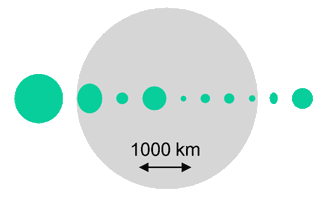.
10 Hygiea
| Discovery A | |
|---|---|
| Discoverer | A. de Gasparis |
| Discovery date | April 12, 1849 |
| Alternate designations |
none B |
| Category | Main belt (Hygiea family) |
| Orbital elements C D | |
|
Epoch July 14, 2004 (JD 2453200.5)
|
|
| Eccentricity (e) | 0.119 |
| Semi-major axis (a) | 469.345 Gm (3.137 AU) |
| Perihelion (q) | 413.378 Gm (2.763 AU) |
| Aphelion (Q) | 525.311 Gm (3.511 AU) |
| Orbital period (P) | 2029.776 d (5.56 a) |
| Mean orbital speed | 16.82 km/s |
| Inclination (i) | 3.842° |
| Longitude of the ascending node (Ω)) |
283.646° |
| Argument of perihelion (ω) |
313.557° |
| Mean anomaly (M) | 273.788° |
| Physical characteristics | |
| Dimensions | 407.1 km |
| Mass | 1.0—1020 kg |
| Density | 2.76 g/cm³ 1 |
| Surface gravity | 0.1603 m/s² |
| Escape velocity | 0.2554 km/s |
| Rotation period | 1.1510 d 2 |
| Spectral class | C-type asteroid |
| Absolute magnitude | 5.43 |
| Albedo | 0.072 3 |
| Mean surface temperature |
~158 K |
10 Hygiea (hye-jee'-a or hi-jee'-a) is the fourth largest main belt asteroid with a diameter of 407 km. The dark-coloured surface makes the asteroid dimmer than the size would imply. Hygiea is composed of primitive carbonaceous material similar to the chondrite meteorites. It is the main member of the Hygiea family.

Size comparison: the first 10 asteroids profiled against Earth's Moon. From left to right, 1 Ceres, 2 Pallas, 3 Juno, 4 Vesta, 5 Astraea, 6 Hebe, 7 Iris, 8 Flora, 9 Metis, and 10 Hygiea. [Source]
Hygiea was discovered by A. de Gasparis on April 12, 1849 in Naples, Italy. It was his first of many asteroid discoveries. It is named after Hygieia, the greek goddess of health, daughter of Asclepius (Aesculapius for the Romans). De Gasparis let his friend Ernesto Capocci name the asteroid to thank him for his encouragement.
The Hubble Space Telescope was able to resolve the spherical shape of the asteroid. So far there are 5 observed stellar occultations by 10 Hygiea.
Aspects
| Stationary, retrograd | Opposition | distance to earth (AU) | maximum brightness | Stationär, prograde | conjunction to sun |
|---|---|---|---|---|---|
| February 5, 2005 | March 26, 2005 | 1.88360 | 9.3 mag | May 13, 2005 | November 21, 2005 |
| May 23, 2006 | July 12, 2006 | 1.86527 | 9.2 mag | August 31, 2006 | February 22, 2007 |
| August 8, 2007 | October 4, 2007 | 2.36399 | 10.1 mag | November 23, 2007 | May 1, 2008 |
| October 9, 2008 | December 3, 2008 | 2.51309 | 10.3 mag | January 26, 2009 | July 4, 2009 |
| December 16, 2009 | February 6, 2010 | 2.16963 | 9.8 mag | March 31, 2010 | September 24, 2010 |
| March 27, 2011 | May 13, 2011 | 1.75632 | 9.1 mag | June 28, 2011 | January 5, 2012 |
| June 29, 2012 | August 22, 2012 | 2.09214 | 9.7 mag | October 11, 2012 | March 26, 2013 |
| September 5, 2013 | October 31, 2013 | 2.49363 | 10.3 mag | December 22, 2013 | May 29, 2014 |
| November 7, 2014 | December 31, 2014 | 2.41334 | 10.1 mag | February 23, 2015 | August 6, 2015 |
| January 25, 2016 | March 15, 2016 | 1.93746 | 9.4 mag | May 3, 2016 | November 8, 2016 |
| May 13, 2017 | June 30, 2017 | 1.82025 | 9.0 mag | August 18, 2017 | February 13, 2018 |
| July 31, 2018 | September 25, 2018 | 2.31617 | 10.1 mag | November 15, 2018 | April 24, 2019 |
| October 3, 2019 | November 27, 2019 | 2.52255 | 10.3 mag | January 20, 2020 | June 26, 2020 |
| December 7, 2020 | January 29, 2021 | 2.22744 | 9.8 mag | March 23, 2021 | September 13, 2021 |
… | Previous asteroid | 10 Hygiea | Next asteroid | …
The minor planets
Vulcanoids | Main belt | Groups and families | Near-Earth objects | Jupiter Trojans
Centaurs | Damocloids | Comets | Trans-Neptunians (Kuiper belt | Scattered disc | Oort cloud)
For other objects and regions, see: Binary asteroids, Asteroid moons and the Solar system
Retrieved from "http://en.wikipedia.org/"
All text is available under the terms of the GNU Free Documentation License

